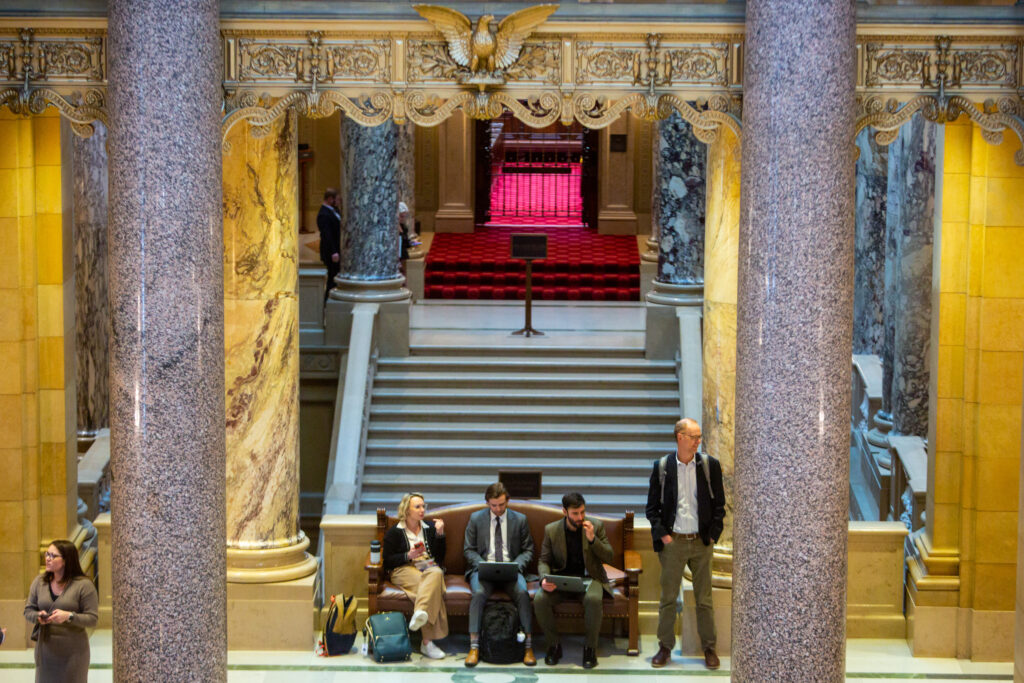Lobbyists wait outside of the Senate chamber during the regular legislative session Monday, March 27, 2023. (Nicole Neri for the Minnesota Reformer)
The 2023 legislative session wasn’t just good for Minnesota progressives. It was also the richest ever for the state’s lobbying corps, according to a new report from a state board.
Minnesota’s corporations, labor unions, advocacy organizations and groups hoping to influence the newly elected Democratic-Farmer-Labor trifecta in 2023 spent $98.4 million on lobbying that year — an 18% increase from the year prior.
The new report from the Minnesota Campaign Finance and Public Disclosure Board shows that lobbying spending ballooned from 2022 to 2023, as did the number of organizations who spent over $3,000 on lobbying during the calendar year. In 2022, the number of organizations represented by lobbyists was 1,483, growing to 1,781 in 2023. The increase may be due to the expanded definition of who needs to register as a lobbyist, but it also could be because of the more anxious organizations that wanted a say during the historic 2023 legislative session.
The DFL trifecta that year passed a bevy of progressive policies, including paid family leave, universal school meals, a carbon-free energy mandate, free college tuition for students from families making less than $80,000, an expanded child tax credit and unprecedented new funding for housing and education.
The state that year also had a $17.5 billion budget surplus, and groups and individuals were eagerly lobbying lawmakers for a piece of it.
Last year was the first year the Legislature was back in full swing after the COVID-19 pandemic. Lobbying spending declined to $68 million in 2020 because the Legislature was largely meeting remotely, limiting the amount of face time lobbyists could get with lawmakers.
Xcel Energy spent the most on lobbying in 2023, nearly $2 million, according to the report. The Minnesota Chamber of Commerce came in second at $1.85 million and Education Minnesota — the state’s teachers union — came in third at $1.64 million. These three groups regularly top the charts of who spends the most on lobbying in Minnesota.
Xcel spent $1.33 million lobbying the Minnesota Public Utilities Commission in 2023. At the time, the energy monopoly was pushing the PUC to approve extending operations of Xcel’s Monticello nuclear plant through 2040.
The Minnesota Chamber of Commerce last year was fiercely opposed to many of the DFL trifecta’s progressive policy initiatives, especially paid family leave. The new state program will begin in 2026 and offer Minnesota workers 12 weeks of paid medical leave and 12 weeks of paid family leave — capped at 20 weeks total in a single year.
The Chamber of Commerce argued that paid leave will cripple Minnesota businesses and create a hostile environment for business growth in Minnesota. On the Chamber of Commerce’s website, it brags about its lobbying influence in limiting the paid leave law.
“The Chamber was successful in scaling back the number of weeks; originally proposed at 24, an exemption for seasonal hospitality workers, a refined definition of family member and an actuarial study,” the Chamber of Commerce’s website states.
Finally, Education Minnesota spent much of the 2023 legislative session advocating for a big boost in education funding. The bill included an increase in the state’s basic funding formula, extended unemployment insurance to hourly school workers and provided additional funding for pre-K.
In 2023, Lyft spent $140,000 on lobbying — a $120,000 increase from the year prior — according to the campaign finance report. That year, Uber and Lyft were furiously lobbying legislators against minimum pay rates. Lobbying spending by Uber was not included in the report, even though Uber employed two lobbyists that year, according to the campaign finance board.

